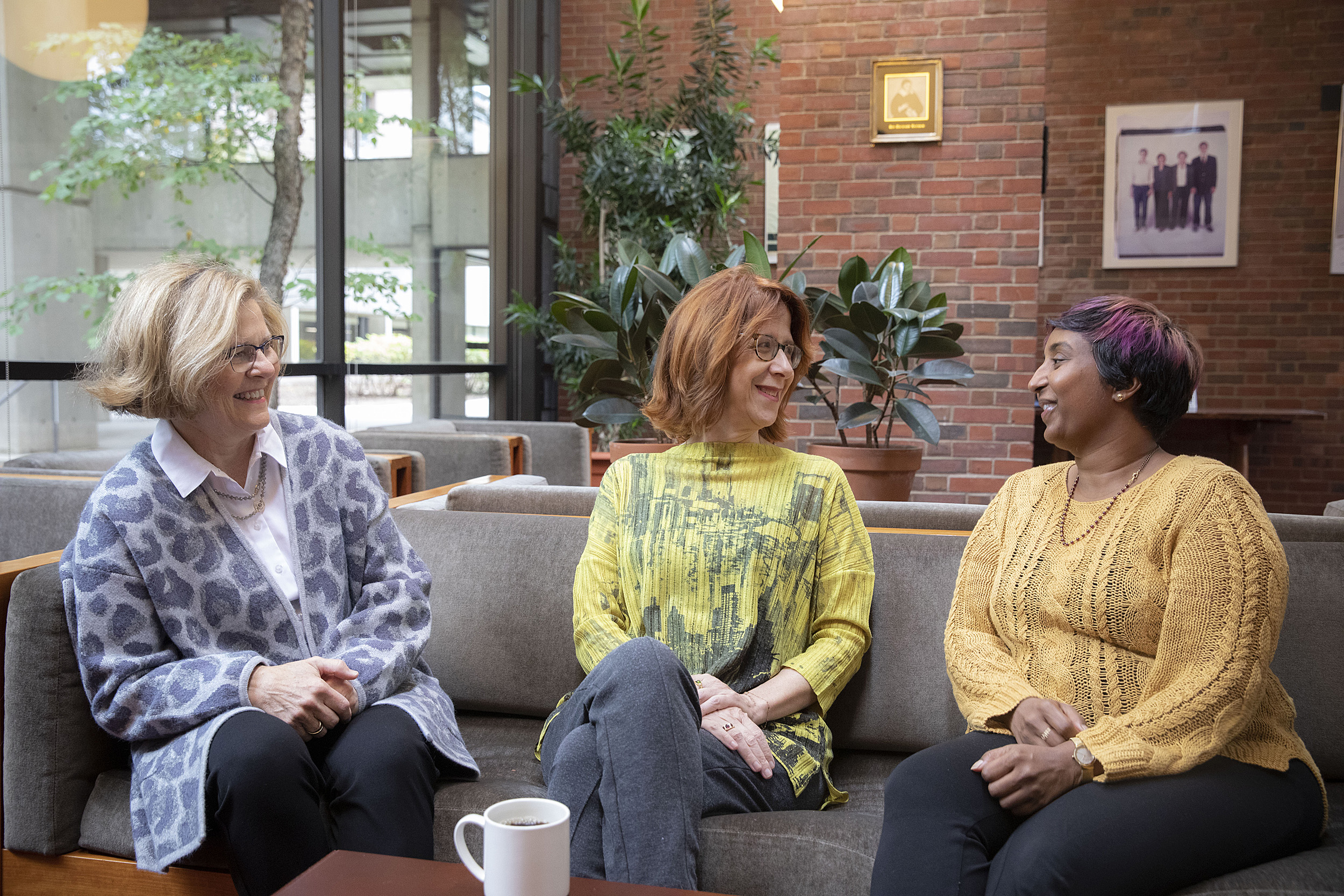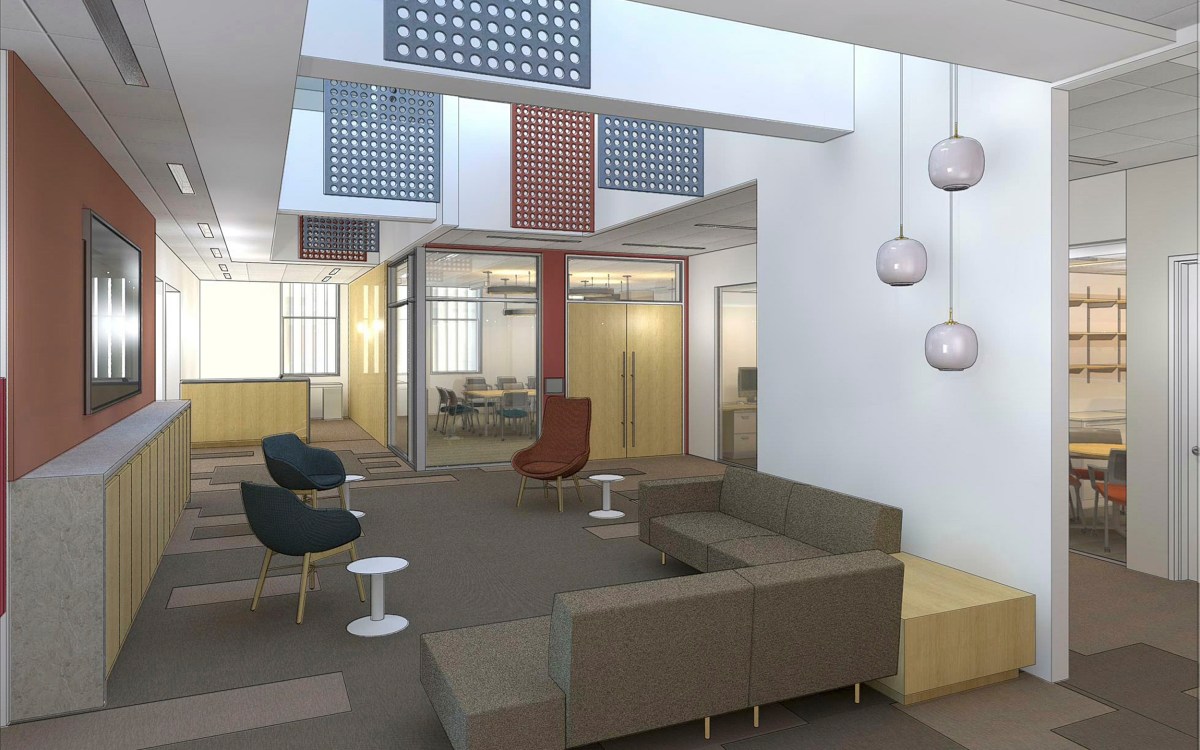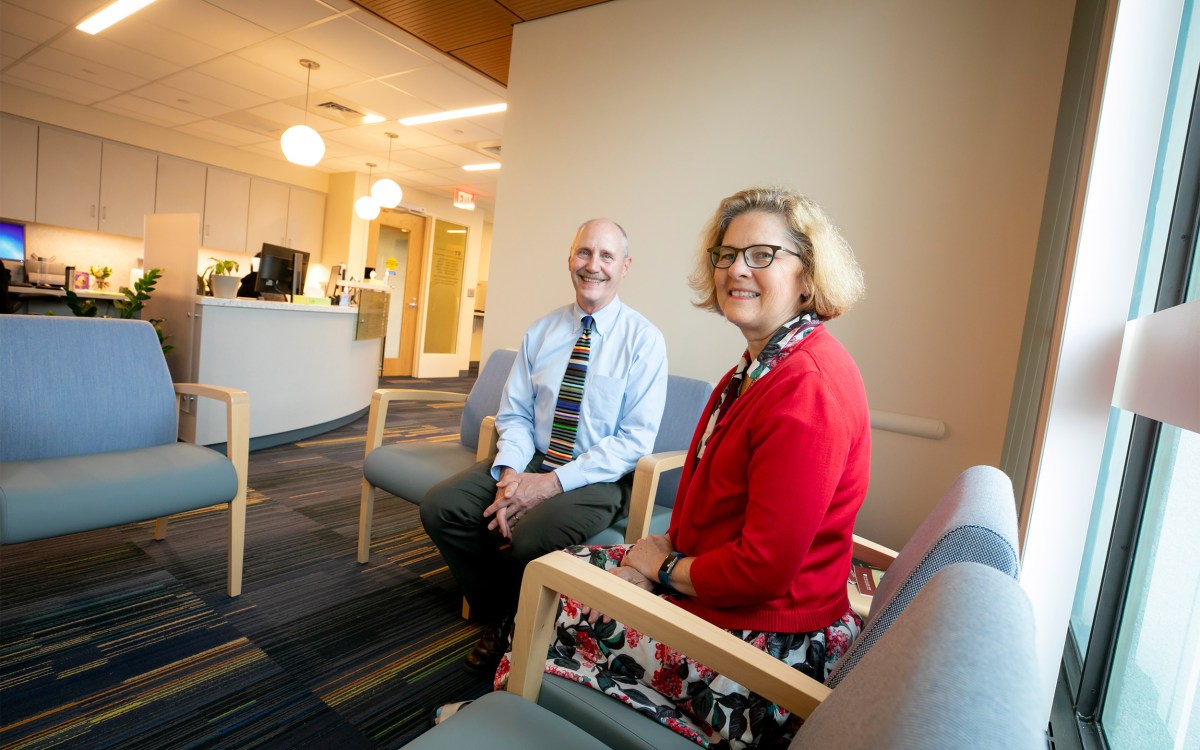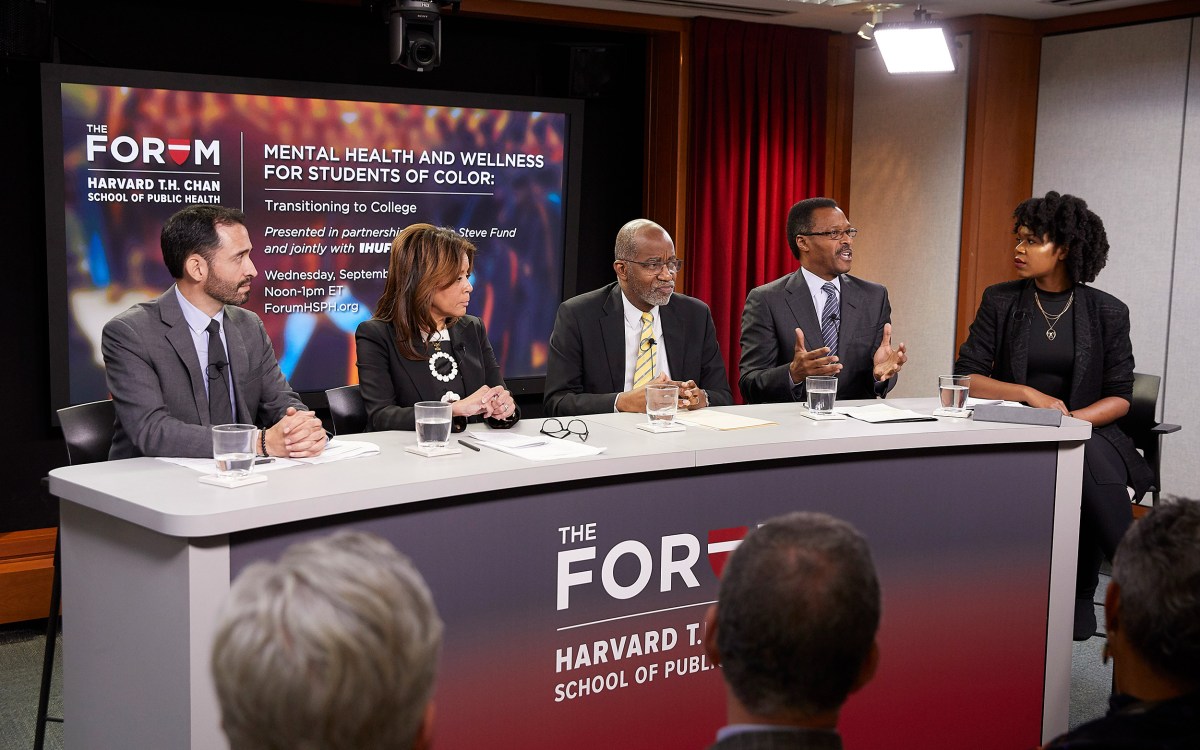
Barbara Lewis (from left), Catherine Shapiro, and Sindhu Revuluri discuss the benefits of the new Academic Resource Center.
Kris Snibbe/Harvard Staff Photographer
Exploring services for students
Network of available resources includes groups to help with academic, social, and emotional challenges
Harvard College recently opened a new Academic Resource Center (ARC), which offers peer tutoring, academic coaching, and opportunities for group and individual study. The ARC complements an array of existing resources to help undergraduates, some of which may be less well-known. So the Gazette caught up with Barbara Lewis, chief of Counseling and Mental Health Services (CAMHS); Sindhumathi Revuluri, associate dean of undergraduate education, who is overseeing the launch of the ARC; and Catherine Shapiro, senior resident dean, to talk about the range of support offices on campus.
Q&A
Barbara Lewis, Sindhumathi Revuluri, and Catherine Shapiro
GAZETTE: Can you tell us what students can expect when they go to the new ARC?
REVULURI: The ARC is there to support students in their academic experience, in their academic journey. We are focusing on the kinds of skills and strategies that we think all students need to have to be successful in a rigorous academic environment. Some students arrive having had lots of practice with these types of skills, and some don’t. We’re talking about things like how to manage time; budget for different activities; prioritize work; get started on things that seem big or overwhelming; read strategically, so that you’re not just reading and highlighting from start to finish, or trying to memorize everything, but instead actually taking an active and smart approach to learning. We do that through workshops, academic coaching, and a robust peer-tutoring program for students who want more assistance from experienced peers. And we’re excited to hear from students about what types of things they would like to be able to practice and learn about. And, of course, we’re working in partnership with colleagues to hear what types of services they think are needed for students. That includes people like Catherine and Barbara, but also faculty.
GAZETTE: What happens when a student comes to your door looking for a particular service that your office isn’t able to offer?
LEWIS: In CAMHS we have a lot of students who are returning from leaves of absence, and part of that process is for our director of acuity services to meet with students. She often finds herself being asked about academic services and what types of things we offer. So she is very frequently bringing up the ARC and sharing the website with people. Since it’s new, we’re really all just starting to learn about it, but we’ve already been talking about it a lot. And to supplement the work at the ARC, CAMHS has started holding workshops every day of the week, and some days we have two. We have workshops on procrastination, how to solve problems taking an evidence-based approach, perfectionism, and compassion — we had a great turnout recently for our first session. So we’re hoping to use these to support the work of the ARC. And then we also work together with students who have attention-deficit disorder (ADD) or learning disorders. They often meet with our counselors initially, but they tend to end up seeing our psychiatrist, and now we can also have them attend the ARC. The ARC is really a piece we had been missing in terms of coaching and helping students who learn differently — especially involving issues about how to manage their work and things like that. As psychiatrists we’re often in the business of not just prescribing medication but helping to offer techniques to students in terms of how they can reach their full potential.
REVULURI: I think with that group of students the other office that we do a lot of work with is the Accessible Education Office. Their work is providing accommodations but not necessarily coaching, and that’s where the ARC can step in and work with those students in a more sustained way, providing accountability and strategies that they can use.
SHAPIRO: I think this really complements the Yard and the House system well, because in the Houses there is often something like Physics Night, or Math Tutoring Night, for example. And for some students that camaraderie is really helpful, but all students are different. Some want to be holed up by themselves in a room somewhere studying alone; others want to be in a wide-open space with lots of fellow students also studying. But in the Houses students are surrounded by peers as well as graduate students, faculty, and staff who can share stories about how they did their work when they were undergraduates, how they learned. We think that provides another layer of support for students. We also pay a lot of attention to students coming into the Houses and making sure that they have some friendly faces to see right when they enter, which is really helpful.
REVULURI: I think the key part of your question is the network and referral. For all of us that means knowing what our own boundaries and limits are, what we can help with and what we can’t, and knowing that there are lots of things we can help with, but when we can’t there are other people who can.
SHAPIRO: And to encourage our students to get support. Some have had support, but in many cases they haven’t ever had to before, or they’ve been the supporters themselves. When we see students dealing with material that they aren’t familiar with it can be really jarring for them. We are all trying to support a culture that normalizes reaching out to resources and using them in the same way that world-class musicians go to camp to learn and world-class athletes use every opportunity to use the coaching resources available to them. It’s a different way of thinking than some of our students have come here with, so we’re always working to try to change that.
LEWIS: Students sometimes feel more comfortable reaching out to one resource over another. So a student may come to CAMHS because they are anxious about not doing well academically but also embarrassed or ashamed to admit to being in that position. So we can help with the anxiety and the adjustment, but we also help connect them to the supports that are in the House, and now we can also connect them to supports in the ARC.
GAZETTE: If students are reluctant to reach out in the first place, what kinds of things are done to break down that stigma and help students take that first step?
“All of us do a lot of referring, and I don’t think any of us ever want to say to a student, ‘You’re in the wrong place.’”
Sindhumathi Revuluri
LEWIS: It helps to have people in the Houses like tutors, proctors, deans, and other supports that students have there. That might be the first stop. And in CAMHS we have a program we started last year called Let’s Talk, which is clinicians in offices on campus where a student can go meet with them for 30 minutes without having to go to a clinic, have an appointment, or have a medical record. So we hope that for students who may not be comfortable with going to an office, this will be a place where they can go to talk to someone and get advice and be in a setting that is a little easier to manage. In some cases a clinician may say that it warrants coming in and making an appointment, but at least it gets the conversation started.
SHAPIRO: For first-years in particular, the proctors and peer-advising fellows [PAFs] are really important. The proctors live in residence with them; they’re right down the hall. The PAFs are not authority figures; they’re peers. So they really help to normalize that experience of being concerned about a math test or whatever they may be worried about. They can give options in a really friendly, informal, matter-of-fact way, which can be very helpful. For a situation like that you don’t have to make an appointment to speak formally with someone about it.
GAZETTE: How have these various services evolved over the years?
LEWIS: Well, the other new resource that students have are the five peer-counseling groups that we supervise. These are students who have a full training in counseling before school starts in the fall. [Volunteer student counseling group] Room 13 was created about 50 years ago. The person whom I consult with graduated from Radcliffe, and she was hired to help understand the counterculture in the 1960s and the rebelliousness that was taking place, and out of that study she created Room 13. They felt students would talk to peers more easily than they would administrators. And then ECHO has been around for about 30 years. That’s the Eating Concerns Hotline and Outreach. And the most recent one, Indigo, was developed about five years ago. In that case students came to us asking if they could start a group to serve first-generation students who were on financial aid and were from groups that felt more marginalized. Let’s Talk has been around for just a few years, though it was developed originally at Cornell about 15 years ago. I think the bread and butter of our work at CAMHS is the individual one-on-one counseling, and that has obviously been around for a long time. But with the changing needs of students and the changes with the way students live in the world, we have tried to make changes to keep up with them.
SHAPIRO: In the Houses and Yards there are yearly training sessions, which we have made adjustments to over the years. We tend to pay more attention now to first-generation students, and also issues of sleep hygiene, nutrition, and exercise. I think we are more intentional in our hiring to try to bring in a range of people so that in a House there are people with a science focus, or a liberal arts focus, people who come from different backgrounds. The constant is we look for people who are friendly, approachable, sensible, and sensitive in the right measure.
GAZETTE: Has social media had an impact on the need for services?
REVULURI: Certainly from the perspective of distraction and time management it is an issue. There are just so many temptations and strains on your time now. Our students are especially active and have always been busy, but now there is a way that even if you’re alone in your room, you’re not really alone. A lot of what we have seen is having to retrain on how to focus and to tune out. We knew that for students who have ADD or ADHD, but now it’s really more of a baseline focus for students.
SHAPIRO: I think the strength of social media is the ability to get a lot of information and the ability to stay connected to people in ways that were a lot harder in the past. But the information overload makes it difficult for people to remember important messages that we send out sometimes because they are just getting so much of it. I think some of the social media that is more anonymous can really be deleterious. In addition, if you’re feeling depressed or ashamed, for example, you can find a pseudo-community by being on social media as opposed to being out in the dining hall or with your friends somewhere. So, we try not to let social media be a distraction, but also not to be a force which makes it harder to really be part of a community. Real community is more nourishing in the long run.
GAZETTE: Has the ubiquitousness of personal technology changed the way you provide services?
LEWIS: I think one of the ways we have tried to make it easier for students to access our services is by having the scheduling of initial consultations on the patient portal, which students have access to 24/7. We also text students reminders of their appointments, with their permission. We also started partnering with I Hope, which is a tele-help company. We first started by offering one-on-one counseling, which didn’t seem as popular. But now we have them provide workshops in the evenings and on Saturdays and that has gone really well. For students who may prefer to do that from the privacy of their room that’s a great option.
“I think some of the social media that is more anonymous can really be deleterious. … So, we try not to let social media be a distraction, but also not to be a force which makes it harder to really be part of a community. Real community is more nourishing in the long run.”
Catherine Shapiro
REVULURI: We’re thinking a lot about offering a productive, hybrid model. One of the things we are seeing is that when a student is looking for some kind of help, they often want it right away, or at least to get started right away. So we’re going to try to put information online and in the Omni App so that we can be helpful and also be an opening for them to come in and meet with a coach or attend a workshop.
GAZETTE: You mentioned the Omni App. What are some of the other ways we connect with students to make sure they know about all these great resources?
SHAPIRO: In the Houses and Yards the faculty deans, resident deans, proctors, and tutors are key. When there’s information overload, there can be a reluctance to face your email. It’s just overwhelming. But it’s helpful when you have a person sitting there face to face with you who can say, “Let’s try this first.” I do think that having some help in taking that first step is really important.
LEWIS: We actually just created a new website in CAMHS this past January, which we keep updated in real time. So our workshops are up to date, all the training and information is updated. We also just added a TV screen in our waiting room, which cycles through a lot of information about various services we have. Obviously that just reaches the students who are already in the waiting room, but ideally they are carrying that back to their friends.
SHAPIRO: Right here in Mather when you walk in the main entrance we have a screen that features announcements from the resident tutors and the faculty and resident deans, and it helps to put names to faces, which is really important.
GAZETTE: Are students generally familiar with where to go for various services, or do you find that you’re spending a lot of time redirecting them?
LEWIS: There’s a lot of redirecting, and a lot of clarifying. We get situations where students are confusing insurance with being seen in HUHS or CAMHS, for example. There’s confusion over how many sessions you get in CAMHS, and misconceptions that keep growing however hard we try to break them down.
SHAPIRO: We can’t think about providing students with resources as an inoculative event where we do a great job of giving it to them at the beginning and then they have it. That’s just not going to work. Students won’t always know what information is going to be important or necessary later, so the work of getting information out is going to be constant. We’ve been working really hard in the [Dean of Students Office] to bridge the gap between the first year and all the information that comes with being new here, to making it a four-year process.
REVULURI: Agreed, and one of the challenges is that when you’re between the ages of 18‒22, as most of our students are, you don’t necessarily know what kind of problem you’re having. You might feel overwhelmed or feel that something is wrong, but you don’t necessarily know that you need this person or that person. It’s really hard to have that level of abstraction and self-awareness. So we see often students coming in, and there are things that we can help them with, but there are other things that we are not equipped to do. So one of our roles is to help sort that out and to help them with the things we know how to do. All of us do a lot of referring, and I don’t think any of us ever want to say to a student, “You’re in the wrong place.” That being said, we do want students to understand that there are sometimes situations where someone else can help them better than the person who is standing in front of them, and in those cases, it’s really about getting them better help.
GAZETTE: So coordination seems like a really important part of making the network of services work. Is that fair?
REVULURI: I think our areas work together at a high level, thinking about what we provide generally for our students. But then we also collaborate on individual student cases, which we of course don’t talk about much, but we are in touch about cases a lot.
SHAPIRO: As a resident dean, if I’m trying to help a student figure out what course to take, I might know that they have a learning disability, which poses a particular challenge. I always want to make sure that I’m making suggestions that will be productive, and being able to reach out to colleagues in the ARC is enormously helpful. We all want to meet students where they are and be effective, but “effective” is not a monolithic category.
LEWIS: I think it’s important for students to know that we do work together all the time. Although we can’t just share information freely, if a student is needing something in the House or through the ARC or Accessible Education, there is a release they have the option of signing which allows us to share some of that documentation.
SHAPIRO: We all do the jobs that we do because we care about our students. All of them.
Interview was edited for clarity and condensed for space.







